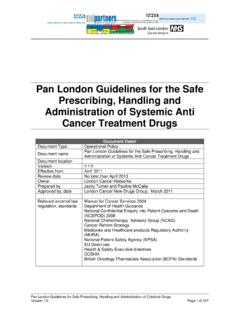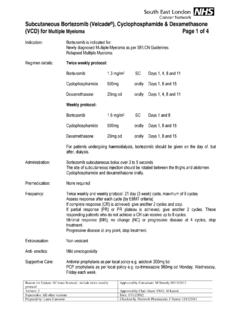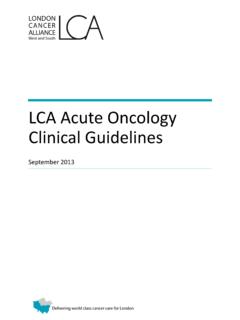Transcription of LCA Haemato-Oncology Clinical Guidelines
1 LCA Haemato-Oncology Clinical Guidelines Lymphoid Malignancies Part 2: Diffuse Large B Cell Lymphoma (DLBCL). August 2015. LCA Haemato-Oncology Clinical Guidelines . Contents 1. Introduction .. 4. 2. Early Diagnosis, Prevention and Risk 5. Clinical features .. 5. Referral pathways .. 5. 3. Investigations and Diagnosis .. 6. Haematology .. 6. Biochemistry .. 6. 6. Imaging .. 6. Diagnosis .. 7. 7. Chromosomal translocations .. 7. Staging .. 8. Further tests and investigations .. 8. 4. Prognostic Indices .. 9. IPI Clinical factors .. 9. 5. Service Configuration across the 11. 6. Patient Information and Support .. 12. 7. Treatment Recommendations .. 13. Early stage disease .. 13. Advanced stage disease .. 13. Relapsed disease .. 14. 8. Supportive 16. 9. End of Treatment Information .. 17. Treatment summary and care plan .. 17. 10. Follow-up Arrangements .. 18. 11. Rehabilitation and Survivorship .. 19. 12. Research and Clinical Trials .. 19. 13. End-of-life Care .. 20. 2. CONTENTS. 14.
2 Further Specific Aggressive B cell NHL Variants .. 21. Mediastinal sclerosing B cell lymphoma .. 21. Primary DLBCL of the testis .. 21. Primary CNS lymphoma (PCNSL) .. 21. DLBCL variant intravascular large B cell lymphoma .. 21. HIV-positive DLBCL .. 22. PTLD DLBCL .. 22. References .. 24. Annex 1: Multidisciplinary Teams (MDTs) and Constituent Hospital Trusts .. 26. Annex 2: SIHMDS or Current Diagnostic Services and Contacts .. 27. Annex 3: JACIE-accredited Transplant Centres in the LCA .. 28. Annex 4: Guideline for the Management of Tumour Lysis Syndrome (TLS) .. 29. Annex 5: Guidelines for Use of Rasburicase in Adult Haematology and oncology 31. Appendices .. 33. 3. LCA Haemato-Oncology Clinical Guidelines . 1. Introduction In western countries diffuse large B cell lymphoma (DLBCL) constitutes 25 30% of adult non-Hodgkin's lymphoma (NHL) and is the most common subtype of NHL. Its incidence rises from 2 cases per 100,000 at 20 24 years of age, to 45 cases per 100,000 by 60 64 years and 112 per 100,000 by 80 84 years with a marginal male predominance.
3 The disease typically presents de novo' but may occur as a progression or transformation of a less aggressive, low-grade lymphoma such as CLL or FCL. Significant risk factors for the development of the disease include underlying immune deficiency, often in the setting of HIV-related illness or in the post solid organ transplant setting. Clinical , biological and molecular studies have categorised DLBCL into morphological variants, molecular and immunophenotypic subtypes and distinct Clinical entities. However, as the disease remains biologically heterogeneous it is not always possible to ascribe a clear definition for subdivision and these cases are classified as DLBCL not otherwise specified (DLBCL NOS). CHOP-R chemo-immunotherapy has become the gold standard of treatment proven in several large randomised trials, but several discrete Clinical entities remain challenging, such as the development of the disease in the elderly with co-morbid illness and patients who are refractory or relapse early after CHOP-R treatment.
4 4. EARLY DIAGNOSIS, PREVENTION AND RISK FACTORS. 2. Early Diagnosis, Prevention and Risk Factors The development of DLBCL has no clear linked genetic factors which would facilitate screening initiatives. However, patients with a history of immune suppression induced by disease (HIV) or drugs (post renal transplant) are at higher risk of developing high-grade B cell lymphoma. Clinical features Patients may present with a rapidly enlarging tumour mass at single or multiple nodal or extranodal sites. Roughly 30 40% patients present with Stage I or Stage II disease. Patients may present with constitutional symptoms which are often dictated by the organ or anatomical site involvement. Triggers for referral may come from an enlarged lymph node from GPs or from specialist medical or surgical teams. Referral pathways Patients with suspected DLBCL should be referred immediately to a haematologist for assessment on a 2 week wait pathway (see Appendix 1: 2 Week Wait Referral Forms). Patients with worrying features such as hypercalcaemia, severe cytopenia or leucocytosis should be discussed with the local haematology department to arrange direct admission.
5 5. LCA Haemato-Oncology Clinical Guidelines . 3. Investigations and Diagnosis All patients require full haematological, biochemical, virological, histopathological and staging investigations. Haematology FBC and differential, ESR, CRP. Biochemistry U&Es, LFTs, uric acid, Ca, PO4, B2M, LDH. Immunoglobulin profile, serum protein electrophoresis. Virology Full hepatitis B profile: Hep B S Ab, Hep B S Ag, Hep B c Ab Hep C Ab status HIV Ab (with counselling and consent) status EBV Ab status. Imaging Contrast enhanced CT scan of neck/chest/abdomen/pelvis PET/CT (desirable with IV contrast). MRI scan if spinal cord involvement/CNS suspected/may be used in pregnancy/patient allergic to iodine contrast. The use of PET/CT is more accurate than CT alone in staging DLBCL. Performing PET/CT at staging also increases the accuracy of remission assessment and improves the accuracy of radiotherapy treatment planning. Contrast-enhanced CT is preferable as part of PET/CT at baseline, but repeat scans can be performed without contrast (unless accurate measurements are required or bowel involvement was part of the disease at baseline).
6 If mid-treatment imaging is performed, PET/CT is the preferred method as it is more accurate than CT alone. However there is no conclusive evidence to change treatment on the basis of interim PET/CT scans at present and results from randomised controlled trials are awaited. However all cases should be assessed on a case by case basis in conjunction with the overall prognosis, other Clinical results, markers of response and/or biopsy if appropriate. Post-treatment remission assessment is most accurate with PET/CT which should be the standard method in Clinical practice. The 5-point scoring system (known as the Deauville criteria) should be used for reporting response on interim and of treatment scans as per international recommendations. For cases with residual uptake who are considered for escalation/salvage treatment, biopsy confirmation is recommended. International consensus Guidelines have been drawn up to guide clinicians about the role of imaging and response assessment of lymphoma.
7 For more information see International Conference Malignant Lymphoma Imaging Working 6. INVESTIGATIONS AND DIAGNOSIS. Diagnosis All patients require an excision lymph node biopsy by designated surgeons (or in some circumstances an incisional core biopsy of an inaccessible lymph node or extralymphatic organ or in rare cases requiring urgent medical treatment). Fine needle aspiration is NOT adequate for the diagnosis. The biopsy should be examined by an expert haematopathologist and tabled for discussion/documentation at the MDT meeting to input into the integrated diagnostic report. Once a recorded histological diagnosis is made each case should be designated an ICD code. Immunophenotype/immunohistochemistry The immunophenotype is obtained by immunohistochemistry performed of formalin fixed paraffin embedded material or by flow cytometry of cell suspension or rarely cell blocks from fresh tissues. All DLBCL B cell components should be confirmed by the presence of one or more pan B cell antigens (CD19, CD20, CD22, CD79a).
8 Surface and or cytoplasmic immunoglobulin (IgM >IgG >IgA) can be demonstrated in 50 75% of cases. CD30 maybe expressed especially in the anaplastic morphological variant. Expression of CD10 is found in 30 60% of cases and BCL6 in 60 90% and IRF-4/MUM-1 in 30 65%. The proliferation fraction as detected by Ki67 staining is high (usually >40%) and often maybe >90%. A cell of origin classification has been proposed with different groups utilising a combination of antibodies to CD10/BCL-6/and IRF-4/MUM-1. Cases with CD10 expression >30% of cells are regarded as GC type as well as cases that are CD10 -, BCL6+, IRF-4/MUM-1 -. All other cases are recognised as non GC type. However, immunophenotyping subdivision does not readily correlate with gene expression based profiling. Currently in routine Clinical practice immunophenotypic sub classification does not determine choice of treatment. Chromosomal translocations Nearly 30% of cases demonstrate abnormalities of the 3q27 region involving the BCL6 gene.
9 Translocations of the BCL-2 gene the hallmark of follicular lymphoma occurs in 20 30% of DLBCL cases. A MyC. rearrangement is present in up to 10% of cases. The break partner is an IG gene in 60% and non IG gene in 40% cases. Twenty per cent of cases with a MyC break have a concurrent IGH-BCL-2 translocation and/or BCL6 break or both. These cases of display high proliferation fractions maybe better categorised as B cell lymphoma unclassified with features intermediate between DLBCL and Burkitt lymphoma'. 7. LCA Haemato-Oncology Clinical Guidelines . Staging Staging is according to the Ann Arbor system: Stage Prognostic groups Stage I Involvement of a single lymph node region (I) or of a single extralymphatic organ or site (IE). Stage II Involvement of two or more lymph node regions (number to be stated) on the same side of the diaphragm (II) or localised involvement of extralymphatic organ or site and of one or more lymph node regions on the same side of the diaphragm (IIE). Stage III Involvement of lymph node regions on both sides of the diaphragm (III) which may also be accompanied by localised involvement of extralymphatic organ or site (IIIE) or by involvement of the spleen (IIIS) or both (IIISE).
10 Stage IV Diffuse or disseminated involvement of one or more extralymphatic organs or tissues with or without associated lymph node enlargement. Organ should be identified by symbols A No symptoms B Fever, drenching night sweats, loss of more than 10% of body weight over 6 months X: Bulky disease: >1/3 mediastinum at the widest point; >10cm maximum diameter of nodal mass E: Involvement of single, contiguous or proximal, extranodal site Further tests and investigations Left ventricular ejection fraction estimation prior to anthracylcine administration in patients with cardiac history/risk factors (hypertension/DM/IHD), elderly >65 years/frail where anthracylcines being considered. Pulmonary function tests. Sperm count and cryopreservation if appropriate. ENT examination. Lumbar puncture if suspected Clinical signs of CNS disease, paranasal, breast, paraspinal/epidural or testicular disease. Cytology assessment by cytospin and flow cytometry performed if suspicious cells seen. Bone marrow examination emerging use of PET/CT is valuable in bone marrow assessment; however, low-volume disease and low-grade disease may be missed, and bone marrow examination may be important in these cases to detect transformed disease where the management approach is different.











